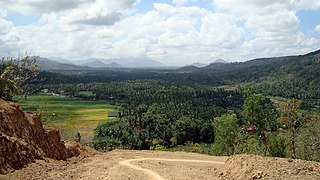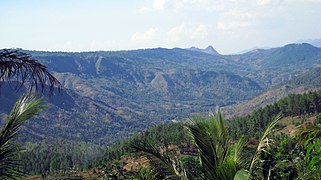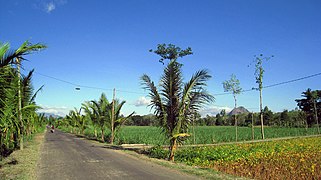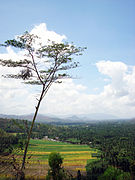world.wikisort.org - Indonesia
Trenggalek Regency is a regency (kabupaten) in East Java, Indonesia.
Trenggalek | |
|---|---|
Regency | |
 Coat of arms | |
| Motto(s): Jwalita Praja Karana (Brilliant because of the people) | |
 Trenggalek Location of Trenggalek in Indonesia | |
| Coordinates: 8°03′S 111°43′E | |
| Country | |
| Province | East Java |
| Government | |
| • Regent | M. Nur Arifin[1] |
| Area | |
| • Total | 1,261.40 km2 (487.03 sq mi) |
| Elevation | 110 m (360 ft) |
| Highest elevation | 2,563 m (8,409 ft) |
| Lowest elevation | 0 m (0 ft) |
| Population (2020 Census)[3] | |
| • Total | 731,125 |
| • Density | 580/km2 (1,500/sq mi) |
| Time zone | UTC+7 |
| Website | trenggalekkab.go.id |
This regency has an area of 1,261.40 km2 and had a population of 674,411 residents at the 2010 Census[4] and 731,125 at the 2020 Census.[5] It is located on the southern shore of East Java and is surrounded by three regencies: Ponorogo to the northwest; Pacitan to the southwest; and Tulungagung to the east. The administrative centre is located in the district (kecamatan) of Trenggalek.
Geography
Trenggalek is a regency that is located on the southern shore of Java island and has the following geographical boundaries:
- To the northwest: Ponorogo;
- To the southwest: Pacitan;
- To the east: Tulungagung;
- To the south: Indian Ocean, and
- To the north: Mount Wilis.
Administrative districts
The Regency is divided into fourteen districts (kecamatan), tabulated below with their areas and their population totals from the 2010 Census[6] and the 2020 Census.[7] The table also includes the location of the district headquarters, the number of administrative villages (rural desa and urban kelurahan) in each district, and its postal codes.
| Name | Area in km2 | Pop'n Census 2010[8] | Pop'n Census 2020[9] | Admin centre | Number of villages | Post codes |
|---|---|---|---|---|---|---|
| Panggul (a) | 131.56 | 69,325 | 78,344 | Wonocoyo | 17 | 66364 |
| Munjungan (b) | 154.80 | 46,916 | 52,908 | Munjungan | 11 | 66365 |
| Watulimo (c) | 154.44 | 62,625 | 70,002 | Prigi | 12 | 66382 |
| Kampak | 79.00 | 35,743 | 37,201 | Bendoagung | 7 | 66373 |
| Dongko | 141.20 | 59,248 | 65,505 | Dongko | 10 | 66363 |
| Pule | 118.12 | 50,908 | 55,822 | Pule | 10 | 66362 |
| Karangan | 50.92 | 45,432 | 49,930 | Karangan | 12 | 66361 |
| Suruh | 50.72 | 24,546 | 26,028 | Suruh | 7 | 66360 |
| Gandusari | 54.96 | 49,082 | 52,560 | Gandusari | 11 | 66372 |
| Durenan | 57.16 | 48,985 | 51,320 | Kendalrejo | 14 | 66381 |
| Pogalan | 41.80 | 47,951 | 52,234 | Ngadirenggo | 10 | 66371 |
| Trenggalek (town) | 61.16 | 62,606 | 64,306 | Ngantru | 15 | 66311 -66319 |
| Tugu | 74.72 | 45,764 | 47,829 | Gondang | 15 | 66352 (d) |
| Bendungan | 90.84 | 25,280 | 27,136 | Dompyong | 8 | 66351 |
| Totals | 1,261,40 | 674,411 | 731,125 | 157 |
Notes: (a) including 11 small offshore islands. (a) including 23 small offshore islands. (a) including 23 small offshore islands.
(d) except for the village of Banaran, which has a post code of 66318.
Commodities

Agricultural produce in the area includes rice, corns, cassava, soya beans, legumes.[citation needed] Plantations produce sugar cane, cloves, durians, salak, mangosteens, and rambutans. Industrial outputs include: soy sauce, syrup, tapioca, anchovies, batik, snacks, cigarettes, sawmill, building materials, roofs, and tofu.[citation needed]
Tourism and cultural sights
Trenggalek has several tourist sites, including beaches (Pantai), caves, and mountain ranges.[10][11]

- Gua Lowo is a cave with examples of stalactites and stalagmites. Based on a cave expert, Mr. Gilbert Manthovani and Dr. Robert K. Kho in 1984, it was declared that Guo Lowo is the biggest natural cave in Southeast Asia with approximately 800 meters of length, nine main rooms, and some small rooms. Guo Lowo literally means "bat cave", owing to the many bats living here when it was first discovered.[12]
- Pantai Prigi. This beach is known for its rock formations.[citation needed] There is also a fish market and a harbor.[13]
- Pantai Pasir Putih. Literally means "white sand beach" and is located adjacent to the Prigi beach.
- Pantai Pelang. This beach has a waterfall and some tiny islands.[citation needed]
- Larung Sembonyo. This traditional ceremony is held annually.
- Pemandian Tapan. This bathing place is located in Karangan and the natural water source comes directly from the mountain ranges.[citation needed]
- Upacara Dam Bagong. Bull's head is swept away in Kali Bagong (Bagong river) in this annually-held ceremony.
- Candi Brongkah. It is a temple which tells the history of Trenggalek.[citation needed]
- Alun-alun Kota. It is the central park in the middle of the city. It also has a playground and snack vendors nearby.[citation needed]
- Tri Turonggo Yakso. It is a typical traditional dance of Trenggalek. The dance belongs to the traditional dance called "jaranan" which is also founding another region. Turonggo Yakso symbolizes the victory of villages in driving away from the devil.[citation needed]
Gallery
- A view over Pucanganak village in western Trenggalek
- Traditional boats are popular among tourists on Prigi beach
- Sunset on Prigi pier
- Skyline of Trenggalek Kota
- Highlands in western Trenggalek
- Plantations in a typical village
- Winding road to Bendungan district in northern Trenggalek
- Village in Trenggalek
See also
- List of regencies and cities of Indonesia
References
- Elected Regent and Vice Regent of Trenggalek for 2010-2015 period Archived 2010-12-13 at the Wayback Machine. Indonesian General Election Commission (KPU) (Indonesian)
- General Situation of Trenggalek. Trenggalek Tourism Board
- Badan Pusat Statistik, Jakarta, 2021.
- [Biro Pusat Statistik, Jakarta, 2011.
- Badan Pusat Statistik, Jakarta, 2021.
- Biro Pusat Statistik, Jakarta, 2011.
- Badan Pusat Statistik, Jakarta, 2021.
- Biro Pusat Statistik, Jakarta, 2011.
- Badan Pusat Statistik, Jakarta, 2021.
- Overview of Trenggalek tourism potentials. Trenggalek Tourism: Cool, calm, and beautiful place.
- Gallery of Trenggalek tourism objects. Trenggalek Tourism: Cool, calm, and beautiful place. Archived February 2, 2009, at the Wayback Machine
- Guo Lowo. Trenggalek Tourism: Cool, calm, and beautiful place. Archived November 3, 2010, at the Wayback Machine
- Prigi beach. Trenggalek Tourism: Cool, calm, and beautiful place.
Другой контент может иметь иную лицензию. Перед использованием материалов сайта WikiSort.org внимательно изучите правила лицензирования конкретных элементов наполнения сайта.
WikiSort.org - проект по пересортировке и дополнению контента Википедии








